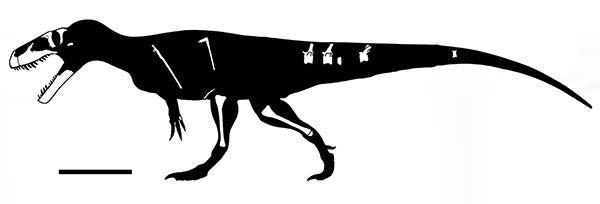This article was published in Scientific American’s former blog network and reflects the views of the author, not necessarily those of Scientific American
As far as anyone has discovered so far, there were no seagoing dinosaurs. All the plesiosaurs, ichthyosaurs, mosasaurs, and other swimming reptiles belonged to other groups distant from the dinosaurs. Dinosaurs never took more than an exploratory plunge into the water. But that doesn't mean dinosaurs are never found in the remnants of ancient seas. The newest dinosaur to be named, Wiehenvenator albati, was found in marine sediments laid down off the edge of an ancient archipelago.
The 166-163 million-year-old carnivore, described by paleontologist Oliver Rauhut and colleagues, was discovered in 1998. It was in that year that geologist Friedrich Albat was examining the rocks of an abandoned quarry near the town of Minden, Germany when he discovered a dinosaur tumbling out of the stone. After years of excavation, preparation, and study, the dinosaur turned out to be something new from a time in dinosaur history that's still little-known.
In the big picture of dinosaur evolution, Wiehenvenator was a megalosauroid. These were the big carnivores of the Middle Jurassic, a time just before the megalosaurs started to be shouldered out by dinosaurs like Ceratosaurus and Allosaurus. And during this time, the world's coasts were very different. Not only were continents stitched together in a different fashion, but high ocean levels created inland seas and archipelagos around the world. Wiehenvenator lived on one such island chain, and somehow its body was washed off dry land for a burial at sea. The fact that a skull of the marine crocodile Metriorhynchus was found in a quarry nearby drives home the point, and brings a sense of symmetry to the dinosaur's final resting place. While in life Wiehenvenator may have picked at dead fishes and crocodiles thrown up onto the Jurassic shore, in death the dinosaur may have fed some of the same species it gobbled up.

The known elements of Wiehenvenator albati. Credit: Rauhut et al., 2016.
Fossil Facts
On supporting science journalism
If you're enjoying this article, consider supporting our award-winning journalism by subscribing. By purchasing a subscription you are helping to ensure the future of impactful stories about the discoveries and ideas shaping our world today.
Name: Wiehenvenator albati
Meaning: Wiehenvenator is a combination of Wiehengebirge, the hills where the dinosaur was found, and the Latin word for hunter. The species name albati honors geologist Friedrich Albat, who found the fossil.
Age: Jurassic, between 166 and 163 million years old.
Where in the world?: Near the town of Minden, Germany.
What sort of critter?: A theropod dinosaur belonging to a group called megalosauroids.
Size: Unknown, but estimated to be over 26 feet long.
How much of the creature’s body is known?: A partial skeleton including elements of the skull, tail vertebrae, ribs, and lower leg.
Reference:
Rauhut, O., Hübner, T., Lanser, K. 2016. A new megalosaurid theropod dinosaur from the late Middle Jurassic (Callovian) of north-western Germany: implications for theropod evolution and faunal turnover in the Jurassic. PalaeontologiaElectronica. 19.2.26A: 1-65
Previous Paleo Profiles:
The Light-Footed Lizard The Maoming Cat Knight’s Egyptian Bat The La Luna Snake The Rio do Rasto Tooth Bob Weir's Otter Egypt's Canine Beast The Vastan Mine Tapir Pangu's Wing The Dawn Megamouth The Genga Lizard The Micro Lion The Mystery Titanosaur The Echo Hunter The Lo Hueco Titan The Three-Branched Cicada